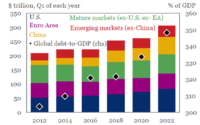China and India look the most threatened from shortages
Women fill water from a municipal tank on May 26, 2023 in the Peth Taluka village in India.
Ritesh Shukla | Getty Images News | Getty Images
Water scarcity is seen as the most significant and potentially most impactful component of the wider climate crisis, and researchers say that large Asian economies like India and China will be the most affected from these water shortages.
Asia is an industrialization hub that is experiencing the most rapid rates of urbanization, and this would require a copious amount of water, Arunabha Ghosh, the CEO of the Council on Energy, Environment and Water, told CNBC on the sidelines of Singapore’s annual Ecosperity Week last Tuesday.
“It’s not just the old industries like steel making, but newer ones like manufacturing semiconductor chips and the transition to clean energy that are going to require a lot of water,” Ghosh said. “Asia is the growth engine of the world, and these industries are new drivers for its economic growth.”
Global fresh water demand is expected to outstrip supply by 40% to 50% by 2030. Ghosh warned that water scarcity must not be viewed as a sectoral issue, but one that “transcends the entire economy.”
Asian economies “must understand that it is a regional common good and it is in their own interest to mitigate the risks that come their way in order to prevent the economic shocks that severe water scarcity will impose,” he said.
India, now the world’s most populous nation, will be the hardest hit from water scarcity. Despite holding 18% of the world’s population, it only has enough water resources for 4% of its people, hence making it the world’s most water-stressed country, the World Bank said.
The South Asian nation relies tremendously on its monsoon season to meet its water demands, but climate change has caused more floods and droughts to hit the country, and has exacerbated its water shortage.
China is in the same rocky boat
According to independent think tank the Lowy Institute, approximately 80% to 90% of China’s groundwater is unfit for consumption, while half of its aquifers are too polluted to be used for industry and farming. Fifty-percent of its river water is also unfit for drinking, and half of that is not safe for agriculture as well.
Although the world’s second-largest economy has made progress in its transition toward clean energy, its power system remains largely dependent on coal. And if there is no water, there will be no coal.
“Water is an essential input for the generation of coal power plants, and if water becomes scarcer or is not available for power generation, that plant becomes ineffective,” Ghosh highlighted.
Other developing countries in the region are in similar situations, but their water crises could be harder to solve. Countries like the Philippines are not as privileged and resilient, so there’s a “huge imbalance in the water crisis that we’re facing,” Shanshan Wang, a Singapore water business leader at sustainability consultancy Arup, said.
A villager drives a herd of sheep on the exposed bed of a reservoir on May 25, 2023 in Kunming, Yunnan Province of China.
Vcg | Visual China Group | Getty Images
India and China are close to seas and rivers, and are more threatened by rising sea levels, but they can afford technology and innovation for better water storage systems, Wang told CNBC on the sidelines of the Singapore International Water Week last Tuesday.
Meanwhile, Wayne Middleton, the Australasian water business leader for Arup said that “we need to stick our hand up and say that we have not recognized the value of our river systems and we have exploited them for industry uses and agriculture.” “We have only recently seen the damage that we have done,” he said.
Countries in the West won’t likely remain unscathed by the risks associated with this water crisis. Europe’s water problem is expected to get worse as resources grow increasingly scarce due to the deepening climate emergency. The region saw temperatures go through the roof in spring, after experiencing a winter heatwave that took a toll on its rivers and ski slopes.
Sectors most affected
Taiwan, home to Asia’s largest semiconductor industry, has once again succumbed to water shortages less than two years after battling the worst drought it had seen in a century. Huge amounts of water are needed to power the plants and manufacture the semiconductor chips that go into our digital devices, and supply can be hindered if shortages occur.
“Taiwan is a big user of hydropower and it always faces a dilemma on whether to store water for its semiconductor industry to utilize, or if the water should be released so they can have more hydroelectricity power,” Wang highlighted.
“Droughts and floods are both a problem for Taiwan, so the industry is unlucky and vulnerable,” she added.

However, Wang noted that although many manufacturing industries do need water to function, water is not actually being used up and could be recycled.
“Water scarcity is not particularly problematic to these industries because a lot of the water can be recycled. The process pollutes the water, and many industries might just want to dump the water directly back into the ecosystem instead of purifying and reusing it,” she said.
“Now that there is a crisis, there are opportunities for businesses to think about how to close the loop … They cannot just take whatever is available in abundance for themselves.”
Water is also playing a huge role in the planned energy transition, and the lack of water could impede countries’ transition to net-zero. In 2022, China experienced its worst heatwave and drought in six decades. Blistering temperatures dried up areas of the Yangtze River, impeding its hydroelectricity capabilities — the country’s second biggest power source.
The Gezhouba dam water conservancy project of the Yangtze River after heavy rain in Yichang, Hubei Province, China.
Future Publishing | Future Publishing | Getty Images
To alleviate energy risks, the country approved the highest number of new coal-fired plants since 2015 last year. Beijing authorized 106 gigawatts of new coal power capacity in 2022, four times higher than a year earlier and the equivalent of 100 large-fired power plants.
“We need a big energy transition to renewables to power our new water supplies, and we need our water supplies to be available for energy security,” Middleton said. “We need to start bringing those two conversations together a lot more.”
Economies that are heavily dependent on agriculture could also see output drop significantly and food security would be at further risk.
According to Australia’s Department of Agriculture, Fisheries and Forestry, the value of agricultural production is expected to fall by 14% to reach $79 billion in 2023 to 2024. This is due to drier conditions that are expected to reduce crop yields from record levels in 2022 to 2023.
“We can certainly build new water supplies and provide water to industries, customers and cities in Australia, but we’re not really able to sustain enough water in longer periods of drought,” Arup’s Middleton pointed out.
“Of course we we have to make water available for our cities and our big economies and our communities, but it leaves behind a growing risk for food production and the agricultural sector,” he said.
[ad_2]
Source link


